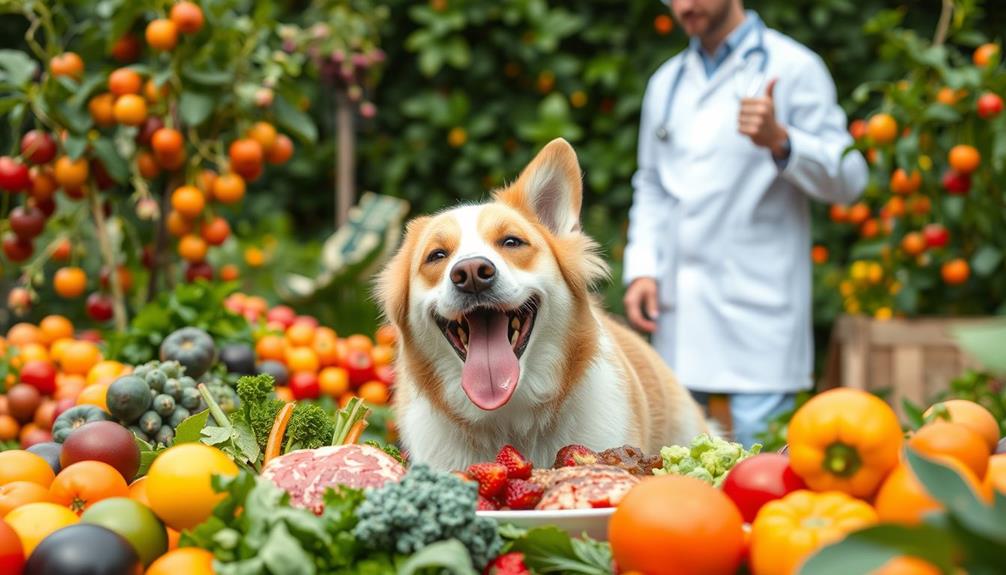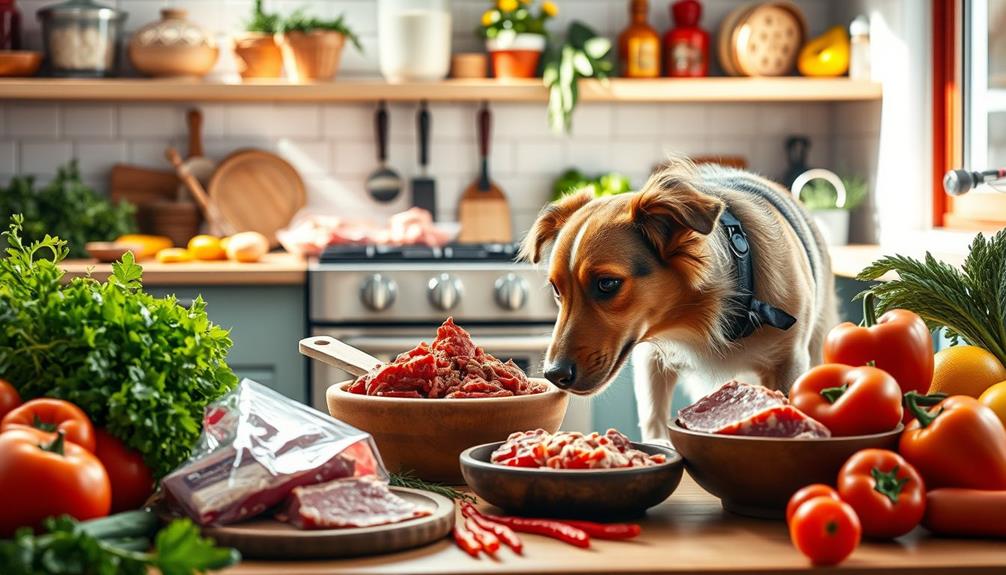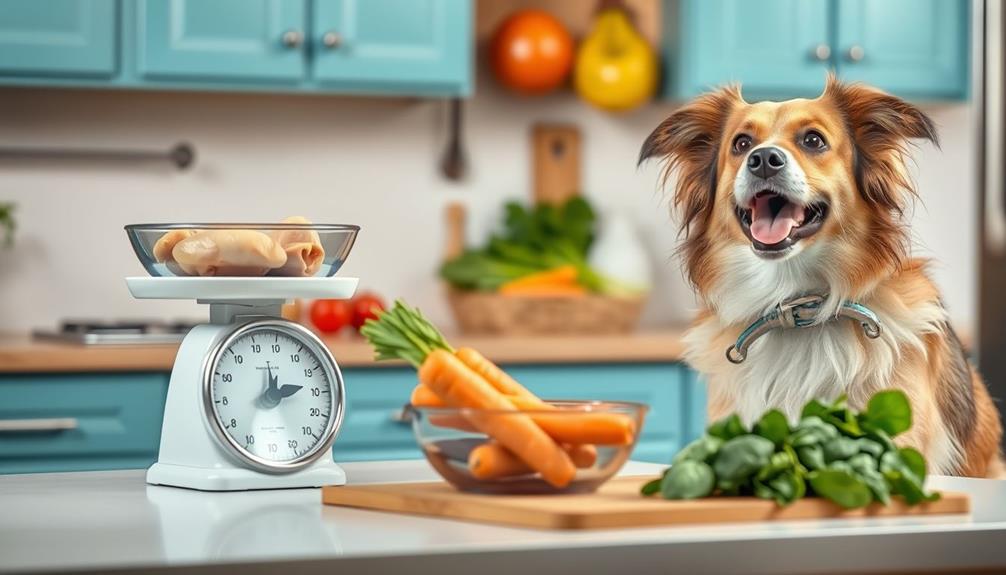Raw food diets for dogs can be beneficial, boosting energy levels and improving coat shine due to higher nutrient content. Many owners notice better digestion and smaller stools. However, you need to be cautious about health risks. Bacterial contamination, like Salmonella, poses dangers not only to your dog but also to your family. Lack of essential nutrients in homemade diets can lead to deficiencies. Experts recommend consulting a veterinarian or nutritionist for balanced diets and evaluating commercially prepared options for safety. There's so much more to evaluate about raw diets and their impact on your furry friend's health.
Key Takeaways
- Raw food diets can enhance dogs' coats, digestion, and energy levels but require careful planning for nutritional balance.
- Health risks, including pathogen contamination and choking hazards, necessitate consulting a veterinarian before starting a raw diet.
- Commercially prepared raw foods with safety measures are recommended over homemade diets to minimize health risks.
- Nutritional deficiencies can arise from poorly planned raw diets, emphasizing the need for expert guidance.
- Alternatives like fresh food diets and AAFCO-standard kibble offer balanced nutrition with reduced health risks for dogs.
Overview of Raw Dog Food
Raw dog food diets aim to bring back the natural eating habits of dogs by incorporating uncooked meat, bones, organ meats, and sometimes fruits and vegetables. This approach mirrors the diet of their wild ancestors and has gained traction since the introduction of the BARF diet by Ian Billinghurst in 1993.
As more pet owners consider raw food diets, you may find yourself among the 15% to 25% of dog owners feeding their pets raw meat-based diets. However, it's important to be aware of the health risks associated with these raw diets. Concerns about bacterial contamination, such as Salmonella and E. coli, have led many mainstream veterinarians and the FDA to warn against potential hazards.
Understanding financial considerations for pet care is also significant as raw diets can be more expensive than traditional kibble. If you decide to explore raw feeding, you'll encounter various options, including home-prepared raw, commercial frozen, and freeze-dried diets. Each type requires careful attention to the nutritional requirements of your dog.
Before moving to a raw diet, consult with your veterinarian to guarantee you're meeting your dog's unique nutritional needs and supporting their immune systems effectively. It's important to make informed choices when feeding your dog a raw food diet.
Benefits of Raw Diets
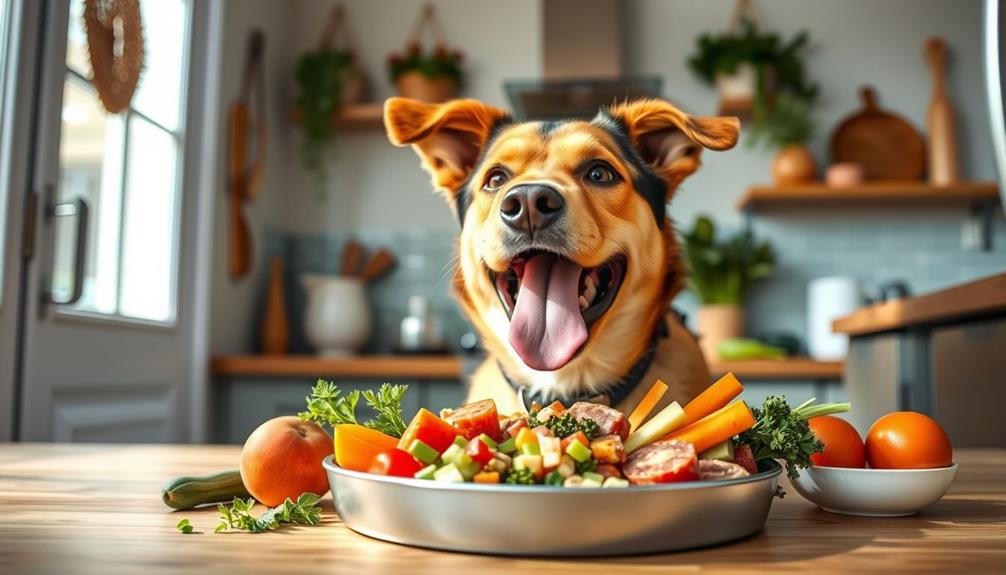
Many dog owners who switch to raw diets report noticeable benefits for their pets, including shinier coats and cleaner teeth. These diets can greatly enhance your dog's overall health and well-being. Here are some key benefits you might observe:
- Shinier Coat: Raw diets often lead to a healthier, shinier coat due to increased healthy fats and essential nutrients. Additionally, the inclusion of fresh ingredients can provide crucial antioxidants, which support immune function and vitality rich in antioxidants.
- Improved Digestion: Many dogs experience better digestion and smaller stool sizes because raw diets are higher in protein and lower in carbohydrates.
- Increased Energy Level: You may notice your dog has more energy for play and exercise, contributing to a better quality of life.
- Management of Food Allergies: Raw diets allow for limited ingredient formulations, which can help manage food allergies by eliminating common allergens found in commercial dog foods.
Additionally, raw diets are rich in antioxidants, which support immune function and vitality. They also promote improved muscle mass and body condition, aligning with the natural dietary patterns of dogs' wild ancestors.
These benefits make raw diets an appealing option for many dog owners.
Health Risks and Concerns
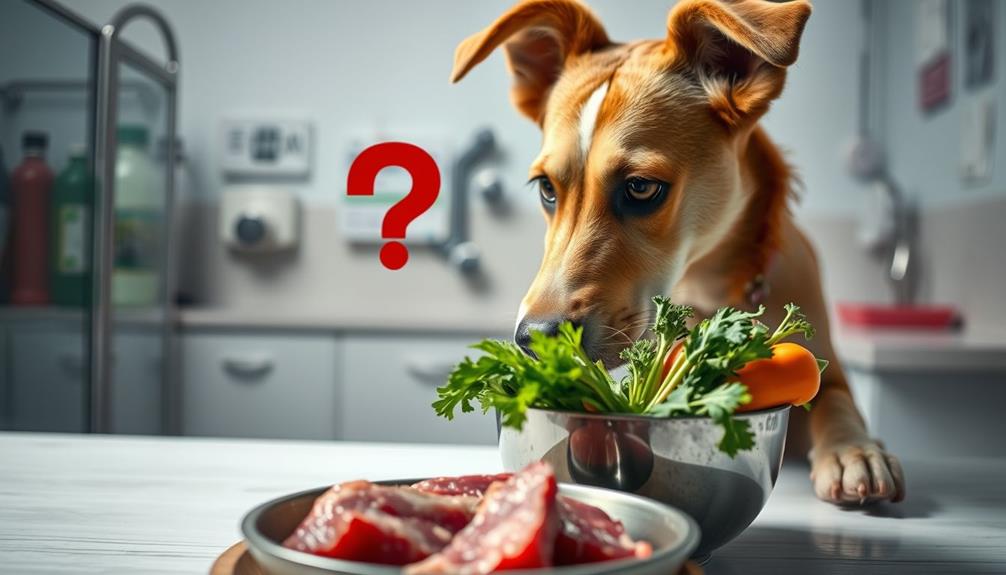
While the appeal of raw food diets for dogs is undeniable, potential health risks and concerns warrant careful consideration. One major issue is the presence of pathogenic bacteria, such as Salmonella and E. coli, which can lead to food-borne illnesses that affect both your dog and your family. The American Veterinary Medical Association strongly advises against feeding raw or undercooked animal proteins due to these contamination risks.
Additionally, it's important to recognize that proper nutritional balance is essential for your dog's health, and common types of cold medications can help manage symptoms that may arise from stress or illness related to dietary changes.
Homemade raw diets can also lead to nutritional imbalances. It's essential to guarantee that your dog gets all the essential vitamins and minerals, which may be lacking in homemade recipes. Many pet owners might unknowingly create a diet that fails to meet their dog's nutritional needs.
Raw bones can also pose significant dangers, as they can cause choking, tooth fractures, and even internal injuries, especially if they splinter. Given these considerable health risks, it's imperative to consult a vet before making any drastic changes to your dog's diet. They can provide guidance on safe feeding practices and help you determine the best nutritional approach for your pet's health.
Expert Recommendations
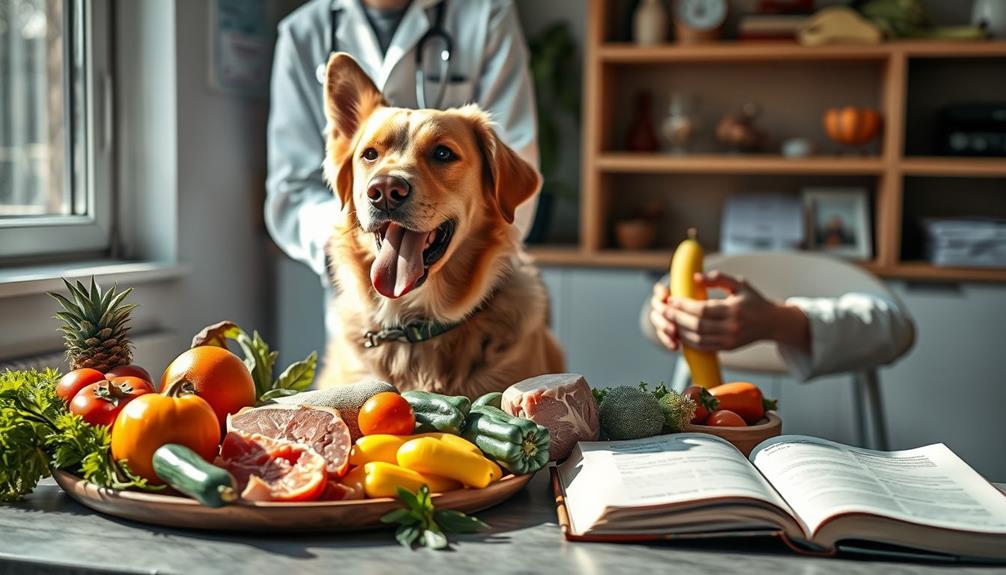
When considering a raw food diet for your dog, it's vital to heed expert recommendations. Many veterinarians, including Dr. Ross Bernstein, discourage feeding raw meat due to significant health risks, particularly the bacteria in raw meat like E. coli and Salmonella.
The American Veterinary Medical Association also advises against it, emphasizing the potential dangers involved. Additionally, it's important to understand the financial implications of your pet's diet, as creating a personal budget can help manage costs associated with specialized pet foods.
Here are four key points experts weigh in on:
- Consult a Veterinary Nutritionist: Before feeding a raw diet, get tailored dietary recommendations to guarantee nutritional adequacy.
- Focus on Balanced Diets: Raw diets often lack essential nutrients, which can lead to deficiencies if not carefully supervised.
- Choose Commercial Pet Foods: Opt for commercially prepared raw food that employs safety measures, such as high-pressure processing, to eliminate pathogens effectively.
- Be Aware of Health Risks: Understand that feeding a raw diet can pose risks not just to your dog, but also to your family due to potential bacterial contamination.
Alternatives to Raw Diets
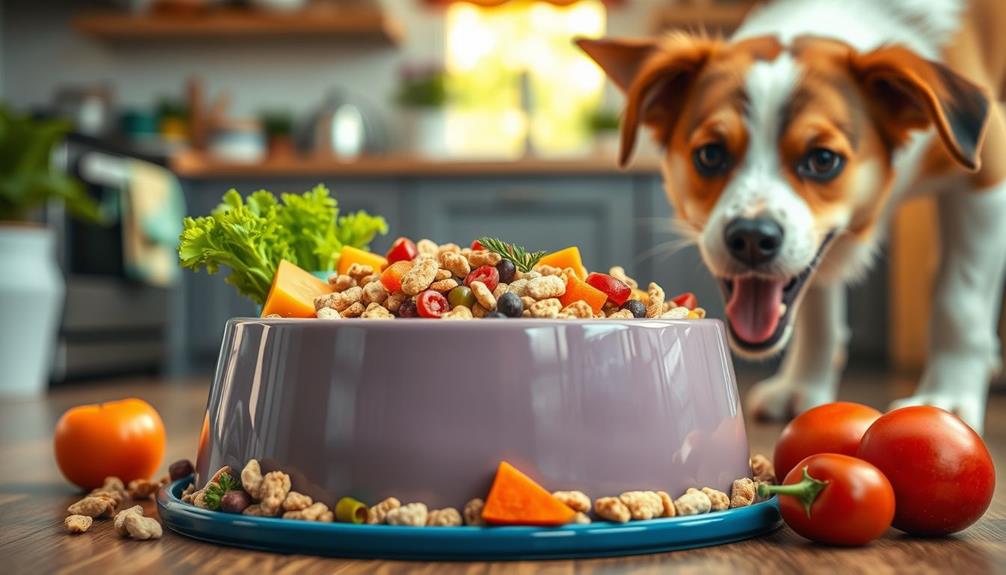
Exploring alternatives to raw diets for dogs can lead you to safer and more balanced feeding options. Fresh food diets, made with natural ingredients like beef, chicken, and vegetables, promote overall well-being and are often delivered pre-portioned for convenience. If your dog has specific health concerns, such as kidney disease, it is important to consult with a veterinarian or animal nutritionist to find a diet that meets their unique needs. In some cases, raw food for dogs with kidney disease may be recommended, as it can provide high-quality protein and essential nutrients while being easier for the kidneys to process. Regardless of the feeding option chosen, it is crucial to ensure that your dog’s diet is well-balanced and meets their individual nutritional requirements.
In addition, many pet owners find that incorporating top-rated vacuums for pet hair into their cleaning routine helps manage fur and dander effectively. Kibble, when formulated to meet AAFCO standards, provides balanced nutrition and helps reduce dental plaque, making it a practical choice for many pet owners.
If you're interested in commercial raw food, some options utilize high-pressure processing (HPP) to eliminate pathogens while still providing a raw diet experience. This approach offers a compromise between raw and conventional feeding.
Additionally, home-cooked meals, under the guidance of veterinary nutritionists, can guarantee balanced nutrition tailored to your dog's specific needs, without the risks associated with raw feeding.
For those managing food allergies, limited ingredient diets—available in both kibble and fresh food formats—can effectively address these concerns while being safer than raw diets.
Frequently Asked Questions
What Do Vets Say About Raw Diet for Dogs?
Vets often caution against raw diets for dogs, highlighting risks like bacterial contamination and nutrient deficiencies. They recommend balanced kibble formulated to meet AAFCO standards, ensuring your pet gets the necessary nutrition safely.
What Do Vets Say About Raw Diet for Dogs?
Veterinarians often express concerns about raw diets for dogs, highlighting risks like bacterial contamination and nutrient deficiencies. They recommend balanced, scientifically formulated kibble as a safer alternative to guarantee your pet's health and well-being.
Is Raw Food Actually Better for Dogs?
You might think raw food's better for dogs, but the risks of bacterial contamination and nutritional imbalances can't be ignored. It's crucial to weigh potential benefits against these serious health concerns before deciding.
Is Raw Food Actually Better for Dogs?
Considering canine cuisine, you'll find raw diets might seem sensational. However, they pose potential pitfalls like nutritional imbalances and health hazards. It's vital to consult a vet before making any drastic dietary decisions for your dog. Raw food for dogs has become an increasingly popular trend, with many claiming that it aids in digestion and improves overall health. However, there is still debate within the veterinary community about the safety and necessity of a raw food diet for dogs. Some experts argue that the risks of potential bacterial contamination and dietary imbalances outweigh any potential benefits. It’s important for pet owners to carefully weigh the potential risks and benefits, and to seek professional advice before making any decisions about feeding raw food to their dogs.
Conclusion
In summary, while raw food diets can offer some benefits for dogs, they also come with significant health risks. For example, consider a dog named Max who thrived on a raw diet initially but later developed severe gastrointestinal issues due to bacteria in improperly handled meat. It's essential to weigh the benefits against the potential hazards. Always consult with your vet to find the best diet for your furry friend, keeping their health and safety as a top priority.

